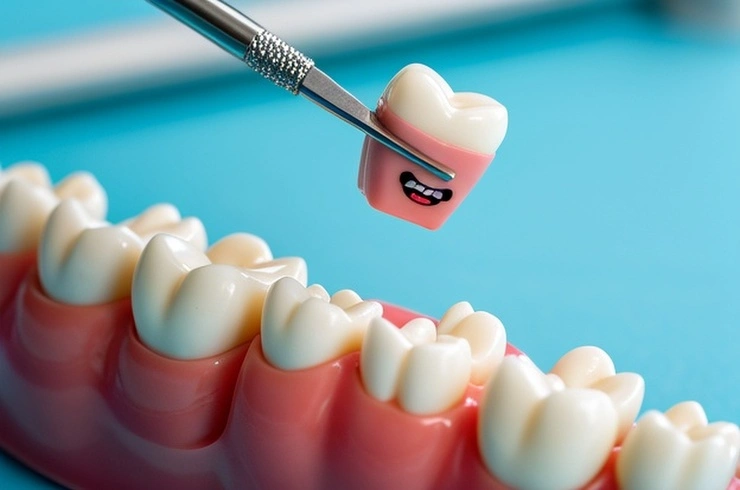
Dental crowns are versatile dental restorations that play a crucial role in maintaining oral health and aesthetics. These custom-made "caps" are meticulously designed to fit over a compromised tooth, effectively restoring its original form, function, and visual appeal. Once cemented into place, a crown completely encases the visible part of the tooth, from the gum line upwards.
When is a Dental Crown Necessary?
A dental crown serves multiple essential purposes, addressing a range of dental concerns for both adults and children:
Protecting Weak or Cracked Teeth: Crowns reinforce teeth weakened by decay or those with cracks, preventing further damage and holding fractured portions together.
Restoring Damaged Teeth: They are ideal for repairing teeth that are already broken or severely worn down, bringing back their structural integrity.
Supporting Large Fillings: When a significant portion of a tooth is missing due to decay or damage, a crown provides the necessary support for a large filling.
Anchoring Dental Bridges: Crowns act as sturdy anchors for dental bridges, securing prosthetic teeth in place.
Cosmetic Enhancement: Crowns can effectively cover misshapen or severely discolored teeth, significantly improving smile aesthetics.
Covering Dental Implants: They serve as the visible, functional part of a dental implant, blending seamlessly with natural teeth.
Pediatric Applications: For children, stainless steel crowns are often recommended for primary (baby) teeth that are extensively decayed, at high risk for decay, or for children who cannot cooperate with extensive dental procedures, reducing the need for repeated general anesthesia. These crowns are cost-effective and fall out naturally with the baby tooth.
Types of Dental Crowns Available:
Permanent dental crowns are fabricated from various materials, each offering distinct advantages:
Stainless Steel Crowns: Primarily used as temporary crowns for permanent teeth or as a definitive restoration for children's primary teeth due to their durability, cost-effectiveness, and ease of placement.
All-Metal Crowns (Gold, Platinum, Base-Metal Alloys): Renowned for their exceptional strength, longevity, and resistance to wear and chipping. Their metallic appearance makes them suitable for less visible molars.
Porcelain-Fused-to-Metal (PFM) Crowns: Offer a blend of strength and aesthetics. They can be color-matched to natural teeth, though the underlying metal can sometimes show as a dark line at the gum line. They are a good option for both front and back teeth, especially for long bridges.
All-Resin Crowns: A more affordable option, but less durable and more prone to fracture and wear compared to other types.
All-Ceramic or All-Porcelain Crowns: Provide the most natural appearance, closely mimicking the translucency of natural teeth. They are also an excellent choice for individuals with metal allergies and can be used on both front and back teeth.
The Crown Placement Process:
Receiving a dental crown typically involves two dental visits:
First Visit: Examination and Preparation:
X-rays are taken to assess the tooth's roots and surrounding bone. A root canal may be performed if extensive decay or infection is present.
The tooth and surrounding gum tissue are numbed.
The tooth is reshaped to accommodate the crown, with the amount removed depending on the crown type. If a significant portion of the tooth is missing, filling material is used to build it up.
An impression of the prepared tooth and surrounding teeth is taken, either with a paste/putty or a digital scanner, to ensure proper bite alignment. These impressions are sent to a dental lab for crown fabrication.
A temporary crown, usually made of acrylic, is placed to protect the prepared tooth while the permanent crown is being made (typically 2-3 weeks).
Second Visit: Permanent Crown Placement:
The temporary crown is removed, and the fit and color of the permanent crown are meticulously checked.
Once satisfactory, the tooth is numbed, and the permanent crown is securely cemented into place.
Caring for Your Temporary Crown:
While awaiting your permanent crown, it's crucial to take precautions with your temporary crown:
Avoid sticky or chewy foods that could dislodge it.
Minimize chewing on the side of your mouth with the temporary crown.
Refrain from biting hard foods.
Slide dental floss out from between your teeth instead of lifting it to prevent pulling off the crown.
Potential Issues with Dental Crowns:
While generally successful, some issues can arise:
Discomfort or Sensitivity: Initial sensitivity to hot or cold is common, especially if the tooth nerve is intact. Pain when biting down indicates a high crown, requiring adjustment by your dentist.
Chipped Crown: Porcelain crowns can chip. Small chips may be repaired, but extensive chipping may necessitate replacement.
Loose Crown: Cement can wash out, causing the crown to loosen and allowing bacteria to enter. Contact your dentist if this occurs.
Crown Falling Off: This can happen due to underlying decay or cement failure. Clean the crown and tooth, and if possible, temporarily re-cement it with dental adhesive before seeing your dentist immediately.
Allergic Reaction: Extremely rare, but possible with metal or porcelain alloys.
Dark Line at Gum Line: Common with porcelain-fused-to-metal crowns, where the metal shows through. This is cosmetic and can be addressed by replacing the crown with an all-ceramic option.
Onlays and 3/4 Crowns:
These are conservative alternatives to full crowns, covering less of the tooth structure.
Lifespan of Dental Crowns:
Dental crowns typically last 5 to 15 years, depending on wear and tear, oral hygiene, and habits like teeth grinding or biting hard objects.
Post-Crown Care:
A crowned tooth still requires diligent oral hygiene. Continue brushing twice daily, flossing daily (especially around the crown and gum line), and using an antibacterial mouthwash to prevent decay and gum disease.
Cost of Dental Crowns:
Crown costs vary by location and material, generally ranging from $800 to $1700 or more. Dental insurance often covers a portion of the cost.
Pro Tip
The content of the article is shared by netizens, please carefully identify it